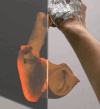Holographic Techniques as a Novel Method for Intervention Planning: A Tertiary Centres Experience
- PMID: 38559839
- PMCID: PMC10976210
- DOI: 10.12865/CHSJ.49.04.15
Holographic Techniques as a Novel Method for Intervention Planning: A Tertiary Centres Experience
Abstract
Advanced holographic visualization techniques are becoming increasingly important in clinical practice, not only for diagnostic purposes but also in the planning of interventional or surgical procedures. The traditional approach for visualizing anatomic structures is based on standard imaging modalities such as echocardiography, cardiac magnetic resonance (CMR) and cardiac CT scan (CCT) which, however, can only provide two-dimensional (2D) images thus limiting 3D perception. Many recent studies have shown that the use of 3D imaging modalities such as augmented reality, virtual reality, mixed reality and holography improve the short and long-term outcome of percutaneous or surgical procedures. In this article, we report our experience on the use of the hologram in different clinical scenarios and in the field of university education.
Keywords: Holography; cardiac interventions; cardiac surgery.
Copyright © 2023, Medical University Publishing House Craiova.
Conflict of interest statement
None to declare.
Figures







References
-
- Chessa M, Van De, Farooqi K, Valverde I, Jung C, Votta E, Sturla F, Diller GP, Brida M, Sun Z, Little SH, Gatzoulis MA. Three-dimensional printing, holograms, computational modelling, and artificial intelligence for adult congenital heart disease care: an exciting future. Eur Heart J. 2022;43(28):2672–2684. - PubMed
-
- Brun H, Bugge RAB, Suther LKR, Birkeland S, Kumar R, Pelanis E, E undefined. OJ. Mixed reality holograms for heart surgery planning: first user experience in congenital heart disease. Eur Heart J Cardiovasc Imaging. 2019;20(8):883–888. - PubMed
LinkOut - more resources
Full Text Sources
